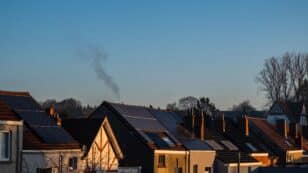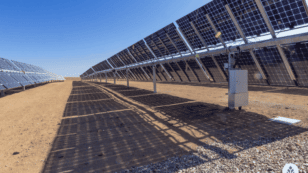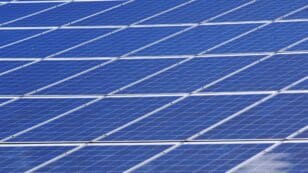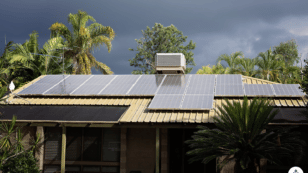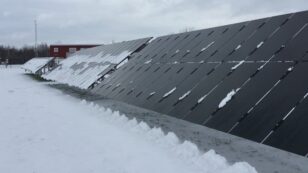
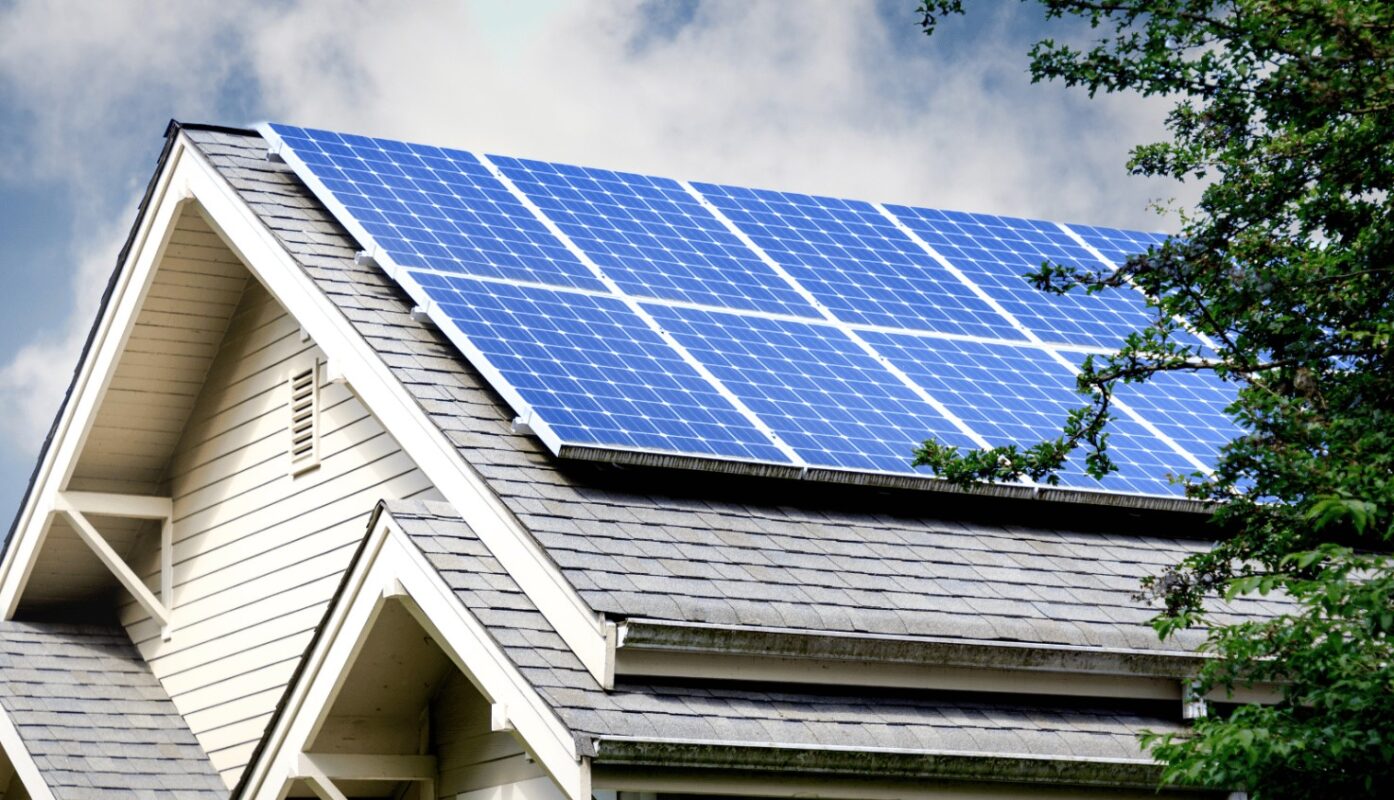
Solar Panel Efficiency Over Time (Plus Tips to Improve It)
In this guide on solar panel efficiency, you’ll learn:
- What is solar panel degradation?
- How has the efficiency of solar panels evolved over time?
- What are ways to improve your panels’ efficiency?
Each product and or company featured here has been independently selected by the writer. You can learn more about our review methodology here. If you make a purchase using the links included, we may earn commission.
You’ll likely read about solar panel or solar cell efficiency in just about every article about panel performance, but many homeowners and solar customers still don’t understand why it’s such a crucial metric in the industry. Ultimately, your panel efficiency rating and degradation over time determine your energy output and, consequently, how much money you save on your utility bills.
In this article, we’ll be discussing why and how panels degrade over time, how long panels typically last, when you should replace them and how to boost performance and production until you do.
Do Solar Panels Lose Efficiency Over Time?
Yes, all solar panels lose efficiency over time, and the rate at which they do depends on a variety of factors, including the panel brand.
Solar panel degradation happens because of constant exposure to UV light, cyclic changes in panel temperature and more, all of which reduce the panel’s ability to absorb sunlight and convert it to usable electricity for your home. We’ll explain the reasons for degradation in greater detail in a later section.
For now, it’s useful to understand just how much efficiency you can expect your solar panel system to lose over time.
The actual rate of degradation depends on the brand of the panel you install, but the average is around 0.5% per year. The only exception is the first year after installation, which is the only time degradation is accelerated. The typical panel loses around 2.5% of its starting efficiency in the first 12 months.
Since most panels come with a 25-year performance warranty, it’s convenient to use that time frame to gauge degradation. With a 2.5% dip in the first year and a 0.5% dip per year over the following 24 years, that leaves you with a total loss of 14.5% and around 85.5% of the starting efficiency at the end of the 25 years.
Since the average panel efficiency starts at around 18.5%, the 14.5% loss would leave you with a total panel efficiency of 15.39% at the end of the 25-year efficiency warranty.

Blue Raven Solar

Regional Service
Average cost
Pros
- Industry-leading in-house financing
- Competitive pricing
- Excellent reputation
Cons
- Doesn't offer solar batteries (coming 2022)

Blue Raven Solar

Regional Service
Average cost
Pros
- Industry-leading in-house financing
- Competitive pricing
- Excellent reputation
Cons
- Doesn't offer solar batteries (coming 2022)
How Has Solar Panel Efficiency Improved Over the Years?
The first solar cell was invented back in 1883 and had an efficiency of below 1%. It wasn’t until about 70 years later that a PV cell with practical application—due to an efficiency rating of around 6%—was invented.
Since the 1950s, there have been a handful of advancements that have helped push panel efficiency higher and higher toward the 22.8% residential panels—under standard test conditions— from SunPower/Maxeon are now capable of. We’ll explain the difference these advancements made briefly below.
- Late 1950s — Monocrystalline solar cells: Monocrystalline solar cells are made from a single sheet of silicon as the semiconductor rather than multiple silicon crystals, as is the case with polycrystalline solar cells. This advancement brought the possible efficiency up from 1% to around 6%, making solar a viable option for energy production.
- 1983 — Solar tracking technology: Panels generate more power when they receive more direct sunlight. In the early 80s, the first sun-tracking mounting system was invented. This didn’t increase cell performance, but it allowed for increased production throughout the day.
- Mid-1980s — Anti-reflective coatings: Anti-reflective coatings help prevent energy from the sun from bouncing off of the rear wall of the solar panel and getting lost to the environment. These coatings were developed in the 1980s, and there have been many iterations and improvements since.
- 1988 — Multi-junction solar cells: Multi-junction cells, also known as tandem cells or tandem perovskite cells, are manufactured using several light-absorbing materials to capture a wider range of solar energy. In the 80s, these peaked efficiency at around 40%. However, given how expensive it was to produce them, the tech was only used for specific applications, like energy production in space.
- 1989 — PERC technology: The first passivated emitter and rear contact (PERC) solar cell was invented. This technology improved efficiency by upwards of 10%, as it allowed for the reabsorption of solar energy that normally would have been lost.
- 2010 — Bifacial panels: Bifacial panels essentially trap solar energy between two surfaces until it can be absorbed by the solar cells inside. This technology was invented in the 70s but wasn’t popularized until around 2010 due to production limitations and cost.
- Early 2020s — Tandem solar cells for commercial production: The multi-junction or tandem solar cells developed in the late 80s started to become viable for use in residential solar systems. They boosted potential efficiency by an additional 25% and could allow for home solar systems to reach efficiencies of around 30%.
Over the years, improvements to the adhesives used for cell connection have also played a role in improving panel efficiency and durability.
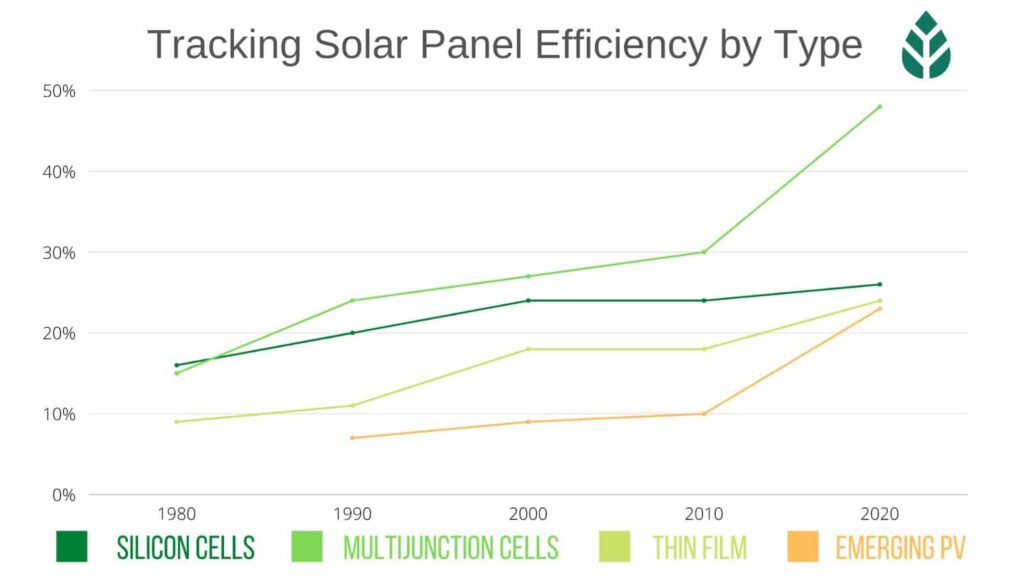
What Affects Solar Panel Degradation?
Environmental factors are mostly to blame for panel degradation, but there are some problems that can stem from the manufacturing of the solar cells as well. The most impactful factors include the following:
- Exposure to ultraviolet (UV) light
- Changes in temperature
- Changes in humidity levels
- Potential-induced degradation (PID)
- Solar cell defects
We’ll discuss why each of these factors can reduce your panel efficiency in the following sections.
Factor 1: Exposure to UV Light
Rooftop solar panels are exposed to sunlight constantly, and the UV light, which gradually causes damage to a wide variety of materials. Included in those materials are those that go into solar cells, any anti-reflective coatings and other components. Over time, damage to these materials will naturally reduce the cells’ ability to absorb light and the protective materials’ ability to reduce losses to the environment.
It’s difficult to quantify how damaging UV light can be to solar cells over a specific time period, but it’s likely largely responsible for the average 0.5% loss of efficiency year over year after the first 12 months of panel operation.
Factor 2: Changes in Temperature
All of the solar cells inside your panels are held together using adhesives and are wired in parallel to generate power and send it to your home. The points where cells are connected and soldered together all expand and contract as the temperature inside the panel changes.
Since solar panels are under direct solar irradiance during the day and are designed to absorb sunlight, they see a much more extreme change in temperature between day and night than we perceive.
This temperature fluctuation, called thermal cycling, will gradually weaken the connections between your solar cells and cause a dip in efficiency.
Again, the amount thermal cycling contributes to efficiency loss isn’t specifically known. However, we expect that a good portion of the average 2.5% drop in efficiency in the first year of operation is largely due to thermal cycling.
Factor 3: Changes in Humidity
Changes in humidity or exposure to high humidity levels can negatively affect panel efficiency in two ways. First, if humidity gets inside your panels—which can happen if there are any manufacturing defects—the moisture can slowly change the conductivity of the silicon cells. This leads to lower production over time.
Second, and more indirectly, high humidity levels combined with changes in temperature can cause condensation on your panels. Those small water droplets can interrupt the sunlight that normally would enter your panel for absorption, leading to decreased production in real time.
Factor 4: Potential-Induced Degradation (PID)
PID is a loss of energy that occurs when there is a high voltage potential difference between the solar cell and other materials in your panels, including those used to wire the cells in series. PID typically stems from an issue with grounding.
Research suggests that PID can lead to a dip in efficiency of up to 30%, making it one of the most severe issues. Thankfully, advancements in solar technology have allowed tier-one modules to resist losses due to PID and resulting leakage currents.
Factor 5: Solar Cell Defects
Finally, manufacturing defects in the solar cells and panels can all accelerate efficiency degradation. Some of the more common issues include microcracks in the silicon solar cells, the use of mismatched solar cell materials that promote PID, over-sized or unders-sized inverters or micro inverters and the use of adhesives that cannot stand up to the thermal cycling expected inside a solar module.
How Will Solar Panel Degradation Affect Your Wallet?
The science behind solar panel degradation might seem confusing, but its effect on your energy savings over time is plain and simple: the more your panels degrade and the more rapidly they degrade, the longer your panel payback period will be and the lower your overall energy savings are expected to be.
The amount you save on your utility bills is directly correlated to panel efficiency over the life cycle of your solar power system because lower production means fewer kilowatt-hours offset and more money you’ll have to pay for energy consumption.
Depending on where you live, your access to net metering, your local electricity rates and how much of your energy demands are met by your solar production, an accelerated dip in panel efficiency could lead to a difference of hundreds or even thousands of dollars in energy savings.
To maximize your solar panel system’s efficiency and durability, you can use the button below to get a quote from SunPower, which manufactures the most efficient solar panels and has some of the lowest degradation rates in the industry.
Do Solar Panel Warranties Account for Efficiency Loss?
Yes, solar panel performance warranties account for efficiency loss and provide a maximum power loss per year throughout the warranty term. The average degradation is 2.5% in the first year and then 0.5% per year after that. That means you’re guaranteed to retain 97.5% efficiency after one year and 85.5% after 25 years.
Since panels typically pay for themselves in around 12 years, the 25-year warranty should be plenty to ensure you come out positive over time. Most homeowners pay for their panels with energy savings and then save an additional $31,513 or more, and the standard 25-year production warranty should be enough to reach these savings yourself.
The best production warranty comes from SunPower solar panels, which also offers the highest starting efficiency available for residential panels. SunPower’s production warranty guarantees a maximum drop of 2% in year one and then 0.25% per year after that. That equates to 98% remaining after one year and 92% remaining after 25 years. The entire warranty term is for 40 years, which is, by far, the longest in the industry.
Some of the lower-quality panels will have even less appealing warranty coverage than the industry average. You’ll also typically see 10-year warranties from DIY solar panel brands, as well as a faster rate of degradation within that term.
4 Tips to Extend the Efficiency of Your Solar Investment
Since panel efficiency is so crucial for maximizing savings and increasing the value of your photovoltaic (PV) system, most customers look for ways to preserve panel efficiency over time. There are four things you can do to accomplish this:
- Avoid installing in shaded areas
- Monitor your system after solar panel installation
- Choose a reliable panel brand
- Only have experienced professionals install your panels
We’ll explain why each of these tips works in the following sections.
Avoid Installing in Shaded Areas
Your panels need to be exposed to direct sunlight to reach their maximum potential, so installing panels in areas that will be shaded by trees, buildings, utility lines or other obstructions will naturally reduce the amount of light and the production rate.
However, portions of your panels that are exposed to direct sunlight will also heat up more rapidly than those in the shade. This can lead to hotspots in your panels, which can accelerate PID and leakage currents.
Monitor Your System After Installation
As mentioned above, hot spots in a panel can lead to efficiency degradation of the module as a whole if not addressed quickly. Hot spots can occur for a variety of reasons, including manufacturer defects, weakened connections and partial shading of your panels.
It’s helpful to have access to a monitoring app to keep track of your production. If you notice an unexpected dip in production and immediately call for service, you could avoid accelerated degradation in your system.
Solar installers and solar panel manufacturers that offer monitoring apps do so for free, so this tip won’t cost you anything but some time and attention to your system’s performance.
Choose a Reliable Panel Brand
Degradation is based on a lot of factors, but choosing a panel made by a high-quality manufacturer can insulate you from a rapid loss of efficiency.
Manufacturers that use cheaper materials often run into accelerated or more severe issues with PID. Things like mismatched solar cells, poor connections between cells and cracks in the silicon layers or protective components can all contribute to greater efficiency losses in shorter timespans.
You might pay a few thousand dollars more for a high-quality panel brand, but you’ll also get anti-PID technology—like the PID elimination process that Q Cells goes through—and, likely, a performance warranty that guarantees greater efficiency over a longer period of time. We strongly recommend investing in a high-quality brand, as the panels are likely to pay for themselves several times over.
Hire a Professional
Finally, we strongly recommend you hire a reliable and reputable solar company to install your solar energy system. Errors during the installation process can lead to cracks in the solar cells or damage to the protective components, both of which can lead to a faster rate of degradation.
You’ll pay a few thousand dollars more for a professional installation than you would if you installed the panels yourself, but you’re likely to see improved energy savings that should make up the difference and more.
How Much Efficiency Loss Before Its Time to Replace Your Solar Panels?
There’s no specific time after which you should replace your panels, so the timeline will depend on ongoing production and how that compares to your energy demands.
Since your system will ideally offset more than you consume immediately after installation, a good time to replace your solar PV system is when you notice that your panels aren’t offsetting your consumption anymore. If you enjoyed $0 electric bills for years and are now seeing your monthly utility bills jump up, it’s probably time to replace your system.
Some homeowners have trouble getting over the upfront cost of solar panel replacement, especially if it’s still partially functional. The average system pays itself off in just 12 years, but if your existing system would still offset at least a good portion of your bill, then the actual offset of your new system will be much longer.
It’s worth considering that older panels come with an increased risk of fire due to less optimized equipment and a higher component failure rate. The risk of roof leaks also increases with system age and constant exposure to the elements.
Ultimately, the peace of mind you get by replacing your system can often be worth the price you’ll pay for a new array, and you’ll have the added benefit of improved energy savings from panels with a superior efficiency rating.
Plus, if you consider that the average system saves around $31,500 over 25 years and that a new system averages around $20,979 after the federal tax credit and other incentives, your replacement system is already almost paid for entirely.
Panel efficiency is a crucial thing to consider when you’re purchasing panels, and degradation is just as important to think about if you already own panels. Whether you’re thinking of installing a clean energy system for the first time or want to replace an aging one on your home, you can use the buttons below to get free quotes and savings estimates from reputable installers in your area.
The cost information presented in this article is derived from a comprehensive analysis, incorporating data from multiple industry sources. The average cost per watt per state was calculated based on figures from Consumer Affairs, Energy Sage, and Berkeley Lab’s Electricity Markets & Policy Department. Additionally, monthly energy consumption and the average monthly cost of electricity were sourced from the U.S. Energy Information Administration, ensuring a well-rounded and accurate representation of the information presented.
FAQs: Solar Panel Warranties
Below, we’ll answer some of the questions we see most often about solar panel warranties, what they include and how they work.
It’s definitely possible. Multi-junction solar cells have reached efficiencies of just under 40% in a laboratory setting at the National Renewable Energy Laboratory (NREL). Multi-junction technology was developed decades ago but is only now starting to be manufactured more efficiently. Improved production processes could instigate further research that pushes that number even higher.
The efficiency of solar panels is determined largely by the type of solar panel. Thin-film panels and polycrystalline panels are much less efficient than panels made with monocrystalline silicon, which are even further from reaching the efficiencies achieved by multi-junction (MJ) cells.
There are some other factors at play that affect overall efficiency as well, including anti-PID technology, anti-reflective coatings and other new technology that is used to reduce solar energy losses and improve absorption to boost conversion efficiency.
The average panel loses 2.5% of its efficiency in year one and an additional 0.5% per year thereafter. That means approximately 7% of the starting efficiency is lost. Although actual panel production in kilowatts varies greatly, if the average 400-watt panel generates 60 kWh per month, that same panel would have a power output of about 55.8 kW per month after ten years.
Panels that are more efficient have a positive effect on the environment in two ways. First, installing high-efficiency panels means solar customers can install fewer panels, which means less potential waste in the long run. Second, a higher efficiency rating means more energy is offset, which means a greater reduction in the amount of fossil fuels one would need to provide power to their home.
Comparing authorized solar partners
-
- Industry-leading in-house financing
- Competitive pricing
- Excellent reputation
- Doesn't offer solar batteries (coming 2022)
A+Best Solar Financing2014Trina Solar, Canadian Solar, SolarEdge, Silfab, SunPower25-year manufacturer warranty; 10-year workmanship warranty, 2-year production guarantee
Having trouble deciding? Click below and use our process to receive multiple quotes instead:

 233k
233k  41k
41k  Subscribe
Subscribe 



